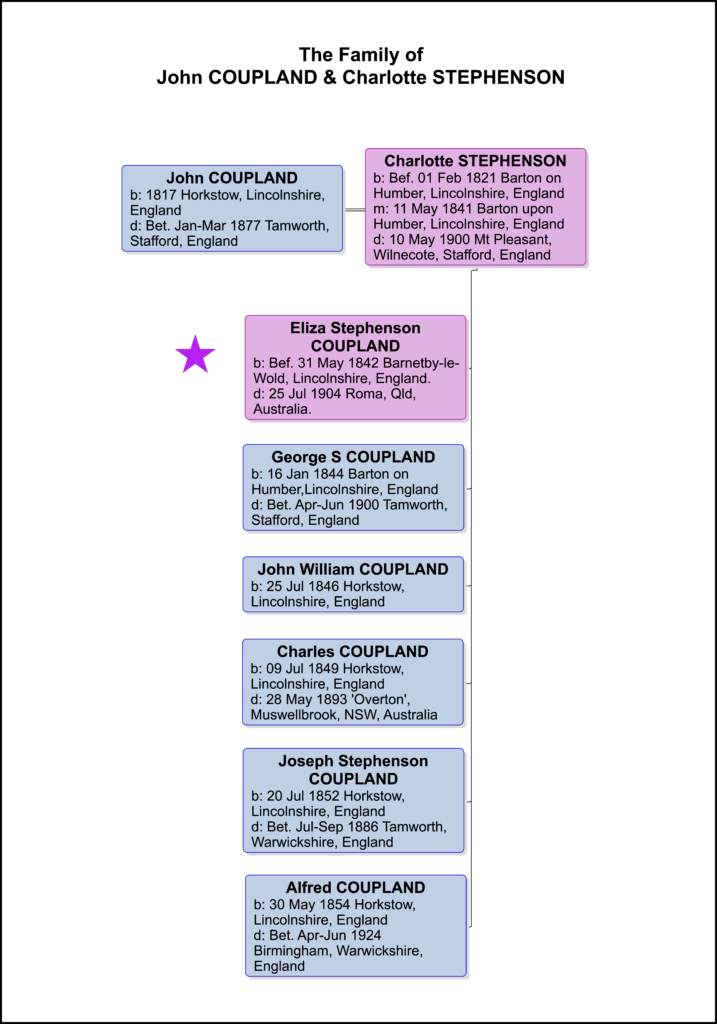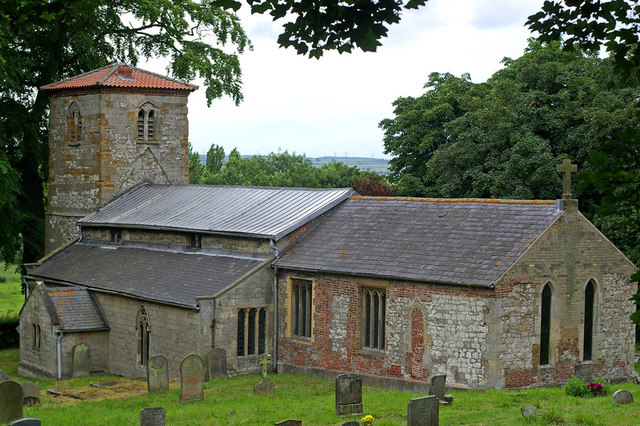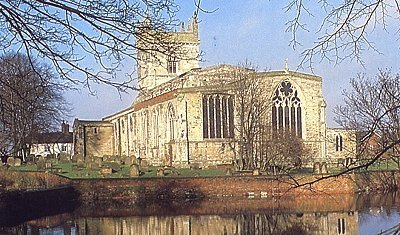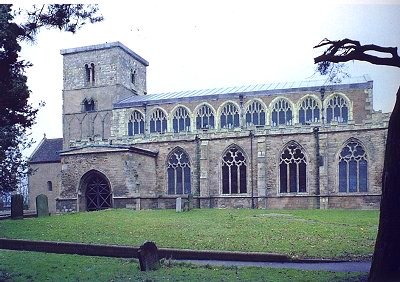The Grand-Parents of George Alfred JOHNSON

John COUPLAND
John Coupland, the third child and only son of John Coupland and Sarah Jacklin, was born in the small village of Horkstow , Lincolnshire in 1817. He was baptised in St Maurice’s Church of England on 20th July of that year.


St Maurice’s was built by the Knights Templar in the 12th century and made of stone and bricks. It was dedicated to the Roman martyr St. Maurice. The church’s interior was partially restored in 1868 and the exterior in 1895. The church seats 190 people.
Horkstow was a small farming village about 6 kilometres from Barton and close to South Ferriby – both places where our ancestors lived.
John probably was an agricultural labourer working on the farms in the area around Horkstow. And he possibly made trips into Barton-Upon-Humber.
Charlotte STEPHENSON
Charlotte was the oldest daughter and second child of John and Mary Stephenson’s brood of 10 children. She was born in 1821 and baptised in February at St. Mary’s Church of England in Barton-Upon-Humber. A description of St Mary’s Church can be found here.

About St Mary’s Church, Barton.
There were actually two Churches of England (Anglican) in Barton – St. Mary’s and St. Peter’s -both within several hundred metres of each other. This may seem strange but I’ll explain why.
“St. Mary’s (previously known as Chapel of All Saints) was probably built of timber during the seventh century. It has undergone many changes throughout the centuries. St. Mary’s was always a church for the people.

The earliest building on the present site dates to the 11th century, of which only the lower part of the tower and the north aisle arcade survive. The majority of the building is in the Early English Style with windows dating from the 14th and 15th centuries and window glass assembled in the 17th century. The porch was restored in 1938.”2
St. Peter’s, when first built during the 10th century, was in effect the Lord of the Manor’s private chapel. It was a building of prestige, where the Lord of the Manor could worship with his family and other noble people who would be there at his invitation. It had a small sanctuary, a small private baptistry and a very limited accommodation in the tower nave.

In 1115, St. Peter’s became a Monastic church ruled and governed by the successive Abbots until the dissolution of the Abbey in 1538 (during the rule of King Henry VIII). The people’s reaction to this granting away of the Church was to continue to maintain for themselves a Church of their own, St. Mary’s, providing their own Chaplains and priests totally independent of the Monastery.
By the 18th and 19th centuries, the Churches were both being used by the people of Barton until St. Peter’s was closed in 1970. It is one of the most architecturally important churches in the north of England and was excavated between 1978 and 1985, with some graves and artefacts dating back 1000 years. St Mary’s became the worshipping Church of England for Barton after this closure.
Charlotte grew up in Barton-Upon-Humber and would have helped her mother with her younger siblings and, no doubt, in her father’s nursery.
As mentioned in her parents story, Pigott’s Directory of 1828-1829 describes Barton-upon-Humber and I have put it into a simple form.
“Barton upon Humber was a large market town situated 268 kilometres north of London on the northern extremity of the Lincolnshire wolds and on the southern bank of the river Humber. Barton was a thriving town with good traffic in corn and flour. It had several factories of starch, Paris white (plaster), sacks, ropes, cables, bricks, tiles and potters-ware. There were also several large tanneries.
Barton benefited from the great northern road passing through it to the Humber river then on to Hull in Yorkshire, with packet-boats, for passengers and carriages, crossing the river daily. It was the main legal centre for the area with courts of recovery of debts, petty sessions and magistrates being held monthly, as well as being the polling station at the election of members to represent the division of Lindsey.
There were 2 Churches of England – St. Mary’s and St. Peter’s, the Roman Catholics, wesleyan and primitive Methodists, and the independents had places of worship. There was a free school, for 20 poor boys, founded in 1722; and sunday and infants’ schools.
The weekly market day was Monday and a market was held once a fortnight for fat and lean cattle; the annual fair was on Trinity-Thursday and the following day, for horses, oxen, sheep and peddlers’ wares.”
Marriage
John and Charlotte were married at St. Peter’s Church of England in Barton-Upon-Humber on 11th May, 1841.3

1841-1851
Within a few weeks of being married, John (aged 24) and Charlotte (aged 20) shifted from Barton-Upon-Humber to Barnetby le Wold, a distance of about 15 kilometres. In the 1841census, they also have several people living with them. There is Sarah Stephenson, aged 12, who was Charlotte’s younger sister. Possibly Charlotte was grooming Sarah into being a housewife and also taking her off her mother’s busy hands. There were also three young labourers, George Nottingham aged 20 years, and Willian Brown and George Leeman aged 15 years. John was also working as an agricultural labourer.
During the years between 1841 and 1851, John and Charlotte’s life changed quite a bit.
They shifted back to Horkstow and lived at 29 High Street. John had risen from being an agricultural labourer to an Estate Bailiff. An Estate Bailiff was employed by the proprietor or owner of a farm or estate. His managerial duties could include collecting rents, taxes, and supervising both farm operations and labourers. He would probably have been able to evict tenants who did not pay rent.
And they had increased their family by four – Eliza (aged 9), George, John William and Charles.
They also had in their household a house servant, Mary Cooling, aged 14, and three farm servants, William Lockwood and John Green both aged 18 and George Grassby, aged 17. And John’s uncle (his mother’s brother), Samuel Jacklin aged 58, was also staying with them and was an agricultural labourer. Charlotte and Mary the servant must have been quite busy.
Interestingly, two houses down the street at number 31 lived John and Sabina Johnson who had a son George aged 11.
1861
John continued living in Horkstow and being a Farm Bailiff for another 10 or so years. He was still there in 1861 with Charlotte, Eliza (18), and Charles. They had had two more children Joseph and Alfred. George and John William had left home. They still had a farm servant, this time Mary Ann Herbert aged 14, and two boarders Charles Smith aged 17 and Joseph Turner aged 15, who were both agricultural servants. No doubt, these young men worked for John on the farm.
And still living two doors away are John and Sabina Johnson with son George aged 21.
1871
Between 1861 and 1865 John, Charlotte and the family made another huge change in their lives. They left Lincolnshire where all their families had lived for generations and moved to Kingsbury near Tamworth in Warwickshire. This is about 187 kilometres which in today’s standard does not seem like very far but in the 1860’s was quite a distance.
We know they moved to the Kingsbury area as both John Coupland and George Johnson are listed at residing at Hockley Hall on the marriage record when George married Eliza in 1865.
Hockley Hall was quite a large farm and the building still stands today. It is very near the Wilnecote Quarry and can be found on a Tithe Plan map of the District of Dosthill c1840. Perhaps John worked here as the Bailiff or was working before getting his own farm.
By 1871, John had acquired land and was a farmer of 68 acres. The whole family obviously moved with them. Three of the sons, George, Joseph and Alfred were living with them and presumably working the farm with John as they are listed as farmer’s sons in the 1871 census. Again they had a relative visiting with them. It was Eliza, the daughter of George Gautby Stephenson, Charlotte’s brother. Perhaps she was helping Charlotte like a servant/maid as Charlotte always seemed to have one.
Of the other three children, John William was a carpenter, boarding in the home of Mary Shaw at 29 High Street, Alrewas in Staffordshire. Alrewas is about 21 kilometres north of Kingsbury.
And Charles had married Lavinia Mason at Tamworth in 1870. He was a labourer and living at Wilnecote, Warwickshire, two doors away from Eliza and George Johnson. Wilnecote was about 5.5 kilometres from Kingsbury.
1871-1900
John probably had just over 10 years as the owner of the farm before he died between January and March, 18774 in the Tamworth area.
I’m not sure what happened to the farm but the three sons who were on the farm in 1871 were not farmers in 1881. Charlotte was living with her son George, in Hockey Road, in Wilnecote. George was a coal miner. Joseph was a colliery engine driver and Alfred was a blacksmith’s striker. All were living in Wilnecote with Charlotte and George living next door to Alfred and Joseph and living in Smithy Lane.
Charlotte and her son, George, lived together for many years. In 1891, they were living at Number 3 Humpherson’s Building. George was now a carter.
Interestingly, Charlotte and George died within 6 days of each other in May 1900. Charlotte died on the 10th May from senility or senile decay. Her death certificate says she was living at Mount Pleasant, Wilnecote. There is a Mount Pleasant Street in present-day Wilnecote, which is a suburban area about 3.2 kilometres South-East of Tamworth. Her daughter-in-law E. Coupland (presumably Elizabeth – John William’s wife) was present at her death.
There is also mention of Charlotte’s death in the Lichfiled Mercury and the Tamworth Herald.

George died 6 days later on 16th May and he is mentioned in the Lichfield Mercury as well.
The Children
Eliza married George Johnson and their story is told here.
We know from above that George never married and died in 1900.
John William started his carpentry career as an apprentice to Joseph Waddington in Habrough, Lincolnshire. I’m not sure what age he started but he was living there in 1861 at the age of 14. He continued carpentry and was a carpenter in 1871 in Alrewas, in Staffordshire. Alrewas is about 21 kilometres north of Kingsbury, so he shifted with the family from Lincolnshire. He married Elizabeth Bird in 1874 in Tamworth and then moved to Derby and then the new township of Normanton in Derbyshire soon after as their three oldest children were born there.
John William continued in the carpentry business, returning to Wilnecote and living at 3 Sharps Row in Smithy Lane in 1891. By 1901, he had moved to 61 Tamworth Road at Twogate and continued living there at least, until 1911. He and Elizabeth had five children. John William died between January and March in 1923 at age 76 years.
As mentioned above, Charles had married Lavinia Mason on 25 September, 1870 in Tamworth. He started being a labourer in Wilnecote in 1871 and he and Lavinia were living two doors away from sister Eliza and her husband George Johnson. By 1881, Charles had become a machine clerk working in the colliery. By 1882, they had had eight children.
In 1883, Charles and Lavinia made a huge decision that would affect the rest of their lives. They decided to immigrate to Australia. Before leaving, Charles and Lavinia had lost their two oldest children, both girls at the very young age of 6 months and two years. So on the 15 July, they emigrated on the ship ‘Dharwar‘ with their other six children. The voyage lasted 77 days and they arrived In Sydney, New South Wales (NSW) on 30 September. Their youngest child, Louisa, died on the voyage. Nine other children under the age of 12 years also died on this voyage. There were 407 immigrants on the ship.
Lavinia must have been pregnant on the journey as she gave birth to a son, Charles in Sydney, NSW soon after arriving. However, he died before the end of 1883.
The family moved to Muswellbrook in the Hunter Valley of NSW and Charles became the manager of the property ‘Overton’. This property was owned by Mr. George Blunt, who raised cattle, sheep and horses, especially Clydesdales or draught horses.
Charles is listed in the 1891 census of New South Wales (NSW) at ‘Overton’ with three males and four females in the household. That is all the NSW census tells us. However, also staying at ‘Overton’ is a G. Johnson, with three males and two females. I am assuming this is Charles’ brother-in-law George Johnson, as there is a mention of the Johnson family going to New South Wales in George Johnson’s obituary and he left some land to his daughter Charlotte who married a Muswellbrook man.
Charles and Lavinia had twelve children with three females and two males pre-deceasing him.
Sadly, Charles died of heart disease in bed on 28 May, 1893 at ‘Overton’. He was only 43 years and had been married to Lavinia for 23 years. There is an article in the Sydney Mail about Charles’ death and also his Death Certificate, which gives the surviving children and deceased children.
When Charles died, he left Lavinia with two small children, Emily aged 4 years and Charles aged 4 months.
Lavinia died in 1937 in Brisbane and the funeral was conducted by her son-in-law Rev. A. E. Atkins, husband of daughter Mary at St. Matthew’s Church in Sherwood. She was buried in the Sherwood Cemetery Brisbane, Queensland.
Fifth child Joseph Stephenson Coupland married Edith Fairfield in 1878 in Tamworth. As mentioned above, after leaving the farm work on his father’s farm, Joseph became a colliery or mine engine driver. Joseph and Edith lived in Smithy Lane in Wilnecote, not far from many of the other family members. They had two children before Joseph tragically died between July and September, 1886 aged 34 years. Edith later married William Goode in 1891 and shifted to Smithwick, Warwickshire.
Last child, Alfred married Fanny Elizabeth Spencer in 1879 in Tamworth. They had three children and lived in Wilnecote, next door to mother Charlotte in Hockley Road in 1881. The family moved to High Street, Dosthill, which is now 2.5 kilometres from the centre of Tamworth. Alfred had several jobs during the next 20 or so years. Like his two brothers, Alfred was a farmer to begin with, then became a blacksmith’s striker and a coal carter working in the pit at the mine.
Alfred died between April and June, 1924 in the Birmingham District. He was aged 69 years. Fanny Elizabeth died in 1941 in Lichfield.
